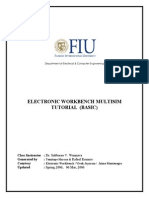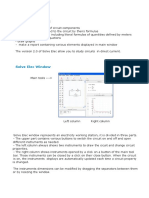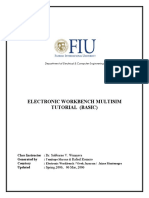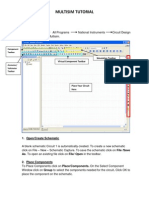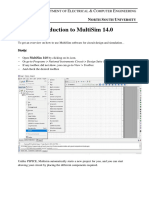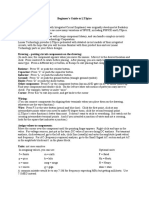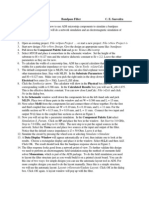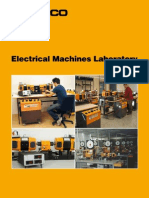0 ratings0% found this document useful (0 votes)
113 viewsSolve Elec
Solve Elec
Uploaded by
cingoski123User Manual for Solve ELEC, free software for educational purposes and teaching electric circuits.
Copyright:
Attribution Non-Commercial (BY-NC)
Available Formats
Download as PDF, TXT or read online from Scribd
Solve Elec
Solve Elec
Uploaded by
cingoski1230 ratings0% found this document useful (0 votes)
113 views35 pagesUser Manual for Solve ELEC, free software for educational purposes and teaching electric circuits.
Copyright
© Attribution Non-Commercial (BY-NC)
Available Formats
PDF, TXT or read online from Scribd
Share this document
Did you find this document useful?
Is this content inappropriate?
User Manual for Solve ELEC, free software for educational purposes and teaching electric circuits.
Copyright:
Attribution Non-Commercial (BY-NC)
Available Formats
Download as PDF, TXT or read online from Scribd
Download as pdf or txt
0 ratings0% found this document useful (0 votes)
113 views35 pagesSolve Elec
Solve Elec
Uploaded by
cingoski123User Manual for Solve ELEC, free software for educational purposes and teaching electric circuits.
Copyright:
Attribution Non-Commercial (BY-NC)
Available Formats
Download as PDF, TXT or read online from Scribd
Download as pdf or txt
You are on page 1of 35
Introduction
Fonctionalities
The version 2.0 of Solve Elec allow you to study circuits in direct current and
alternating current.
-With Solve Elec you can :
= draw a circuit
- modify the properties of circuit components
- define new circuit related entities by their formulas
- see the circuit solution including literal formulas of entities defined by measure
devices
- verify circuit related equations
- draw graphs
- make a report containing various elements displayed in main window
In alternating current you can also :
- display graphs of voltages, potentials ans intensities with an oscilloscope
~ get the transfert functions of circuits and their frequency response graphs.
Solve Elec Window
Main tools -~ = Ox Vv Sk #
Circuit edition tools
Circuit properties -~
Left column Right column
Solve Elec window represents an electricity working station, it is divided in three parts.
- The upper part contains various buttons to switch the circuit on and off and open
different instruments as needed.
- The left column always shows two instruments to draw the cicuit and change circuit
properties.
- The right column shows instruments opened by a click on a button of the main tool
bar. Those instruments can be closed by a click on their close button. When the circuit
is on, the instruments displays are automatically updated each time a circuit property
is changed.
The instruments dimensions can be modified by dragging the separators between them
or by resizing the window.
Direct current (DC) and alternating current (AC)
The button at top left corner of the window indicates the circuit operating mode.
Click that button to change the operating mode : the window will display a new
empty circuit, as some components can't be used in AC and DC.
SSS CDirect current
The circuit may contain the following components :
switch, resistor, potentiometer, diodes, voltage and intensity sources,
integrated amplifier, transistor. The voltage sources drive a constant voltage,
the intensity sources drive a constant intensity.
N Sinusoidal alternating current.
The voltages, intensities and potentials are sine waves of same frequency.
Example for a voltage : u(t) = Umax sin( w t + @ ) with an amplitude Umax,
a pulsation w, a phase 8.
Umax
The rms value of uis | Urms.
The frequency fis f = ——
quency 20
The sine waves are represented as complex values visible in circuit properties.
Complex quantities are written in bold.
The complex representation is used to solve the circuit. The complex formulas,
rms values and phases are computed and displayed in the solution.
In AC current all components must be linear to ensure that the voltages and
intensities are sine waves. The circuit may contain the following components :
switch, resistor, potentiometer, voltage and intensity sources, integrated
amplifier in linear mode only.
Circ drawing
The circuit is drawn and modified with the tools displayed in the box on the left of the
drawing. The circuit is automatically switched off when it is modified.
Adding a component
ae 3
- Click a component displayed in the left box, move the mouse and
“D+ TBF click inside the drawing on the location where you want to insert the
= component.
oO -O-
oS - Type ron the keyboard to rotate the component before inserting it in
SD the drawing.
> K - The component won't be inserted if there is not enough room for it
around the clicked location. Components and wires can't overlay each
QD ® other.
MUA
Drawing and modifying wires
Adding a wire
- Choose wire tool and drag on the circuit to draw a new wire.
- The wires are horizontal or vertical.
Changing a wire length
- Select the wire and drag one of its endings
Contact between to cros:
- By default two crossing wires have no electrical contact.
- Choose contact tool and click the intersection point of two wires to add or remove
a contact
9 wires
Crossing wires without electrical contact
Crossing wires with electrical contact
You might also like
- Introduction to the simulation of power plants for EBSILON®Professional Version 15From EverandIntroduction to the simulation of power plants for EBSILON®Professional Version 15No ratings yet
- LTSpice PresentationDocument48 pagesLTSpice PresentationXafran KhanNo ratings yet
- Work Bench PDFDocument25 pagesWork Bench PDFJimi DbonoNo ratings yet
- Abc of Power Modules: Functionality, Structure and Handling of a Power ModuleFrom EverandAbc of Power Modules: Functionality, Structure and Handling of a Power ModuleNo ratings yet
- Experiment 4Document4 pagesExperiment 4Mohsin Munawar67% (3)
- MATHS - 1A QUESTION BANK - Chapter Wise Important Questions For IPEDocument19 pagesMATHS - 1A QUESTION BANK - Chapter Wise Important Questions For IPESairam Varma M88% (72)
- Solve Elec 2-5 Help WindowsDocument35 pagesSolve Elec 2-5 Help WindowsJerome EugeneNo ratings yet
- Manual Solve ElecDocument28 pagesManual Solve ElecHenry HcNo ratings yet
- LTSpice TutorialDocument5 pagesLTSpice TutorialNanta FakihNo ratings yet
- ElplekDocument236 pagesElplekindhu.csNo ratings yet
- Lab0: Introduction To Ltspice For Electronics - I: by Naeem Maroof Venue: Electronics Lab Ee Department, Ciit IslamabadDocument47 pagesLab0: Introduction To Ltspice For Electronics - I: by Naeem Maroof Venue: Electronics Lab Ee Department, Ciit IslamabadRabia BasharatNo ratings yet
- TINA Tutorial: Starting UpDocument10 pagesTINA Tutorial: Starting UpĐinh Bá ThànhNo ratings yet
- Simulating DC Circuits Using Pspice SoftwareDocument8 pagesSimulating DC Circuits Using Pspice SoftwareAhmar KhanNo ratings yet
- Multisim Software TutorialDocument33 pagesMultisim Software TutorialJohn LeungNo ratings yet
- Tutorial 3 Drawing A Test Probe CircuitDocument10 pagesTutorial 3 Drawing A Test Probe CircuitFernando Valente100% (1)
- Electronic Workbench Multisim Tutorial (Basic)Document25 pagesElectronic Workbench Multisim Tutorial (Basic)ជើងកាង ភូមិNo ratings yet
- MultiSim TutorialDocument25 pagesMultiSim TutorialskelleonNo ratings yet
- 311 SPICE TutorialDocument9 pages311 SPICE TutorialBsomething1978No ratings yet
- Multisim TutorialDocument9 pagesMultisim Tutorialapi-240822427No ratings yet
- LTSpice Tutorial PDFDocument43 pagesLTSpice Tutorial PDFRasoul Gmdri100% (1)
- EEE111 Multisim ManualDocument14 pagesEEE111 Multisim ManualSHADOW manNo ratings yet
- Beginner's Guide To LTSpiceDocument10 pagesBeginner's Guide To LTSpiceNicolás VillegasNo ratings yet
- Multisim Tutorial: An Introduction To The InterfaceDocument33 pagesMultisim Tutorial: An Introduction To The InterfaceYengchien WongNo ratings yet
- MtE-205 EPD LAB 03Document7 pagesMtE-205 EPD LAB 03Syed Suleman Ayub - Section-BNo ratings yet
- PASAN ManualDocument14 pagesPASAN Manualbruno magalhãesNo ratings yet
- Live Wire TutorialDocument6 pagesLive Wire TutorialMagfur RamdhaniNo ratings yet
- PSPICE Tutorial: A Simple DC Circuit: Getting StartedDocument19 pagesPSPICE Tutorial: A Simple DC Circuit: Getting StartedPulakrit BokalialNo ratings yet
- Etap Power Station 4Document14 pagesEtap Power Station 4MohamedHussein MohamedHusseinNo ratings yet
- Tutorial 1 Drawing A Transistor Sensing CircuitDocument7 pagesTutorial 1 Drawing A Transistor Sensing CircuitFernando ValenteNo ratings yet
- Panels and Push-Buttons: Geometry and Material PanelDocument2 pagesPanels and Push-Buttons: Geometry and Material Panelडॉ. कनिष्क शर्माNo ratings yet
- Concise Multi SimDocument17 pagesConcise Multi SimMULUKEN DESALEGNNo ratings yet
- PstarguideDocument72 pagesPstarguidesharan kommiNo ratings yet
- Lab - 2 Handout-ELEC 201Document11 pagesLab - 2 Handout-ELEC 201AmroKashtNo ratings yet
- LTSpiceShortGuide 230805 170814Document13 pagesLTSpiceShortGuide 230805 170814ghasNo ratings yet
- GeckoCIRCUITS Beginners TutorialDocument21 pagesGeckoCIRCUITS Beginners TutorialLuis Enrique JiménezNo ratings yet
- Electronics and Electricity Chapter 1 Multisim Laboratory: Introduction To Virtual vs. Real (Or Live) ComponentsDocument13 pagesElectronics and Electricity Chapter 1 Multisim Laboratory: Introduction To Virtual vs. Real (Or Live) ComponentsRubia IftikharNo ratings yet
- MultiSim 8 Quick StartDocument8 pagesMultiSim 8 Quick StartRahul SushruthNo ratings yet
- Electronic Workbench Multisim Tutorial (Basic)Document25 pagesElectronic Workbench Multisim Tutorial (Basic)Silver WolvesNo ratings yet
- Autocad Plant3d Quick Reference GuideDocument2 pagesAutocad Plant3d Quick Reference GuideashrafNo ratings yet
- Lecture 18: Circuit Simulation in ProteusDocument7 pagesLecture 18: Circuit Simulation in ProteusHuzaifa RehanNo ratings yet
- Tutorial: Water Hammer (Part 2)Document9 pagesTutorial: Water Hammer (Part 2)shaffetiNo ratings yet
- PCB Wizard 3 Tutorial 1: Drawing A Transistor Sensing CircuitDocument7 pagesPCB Wizard 3 Tutorial 1: Drawing A Transistor Sensing CircuitLuly PerezkNo ratings yet
- HP Prime Electric & Electronic Circuit Solver (EEC - Solver)Document12 pagesHP Prime Electric & Electronic Circuit Solver (EEC - Solver)Dae Hyun KimNo ratings yet
- ADS Single Stub TutorialDocument24 pagesADS Single Stub TutoriallafxNo ratings yet
- Electromechanical Systems SimulatorDocument18 pagesElectromechanical Systems SimulatorLuis Wilber Humpiri VelasquezNo ratings yet
- ATPDraw 5 User Manual UpdatesDocument51 pagesATPDraw 5 User Manual UpdatesdoniluzNo ratings yet
- Activity 1 - LTspice FamiliarizationDocument5 pagesActivity 1 - LTspice FamiliarizationHans PinonNo ratings yet
- Eca Lab Manual Using PspiceDocument30 pagesEca Lab Manual Using PspiceArjun AryanNo ratings yet
- GeckoCIRCUITS Tutorial Basics enDocument16 pagesGeckoCIRCUITS Tutorial Basics enKlebber De Araujo OttoboniNo ratings yet
- ADS Tutorial 2Document4 pagesADS Tutorial 2Minh VuNo ratings yet
- ET 304A Laboratory Tutorial-Circuitmaker For Transient and Frequency AnalysisDocument7 pagesET 304A Laboratory Tutorial-Circuitmaker For Transient and Frequency AnalysisZhong XiangNo ratings yet
- Lab ManualDocument12 pagesLab ManualAvinash VikramNo ratings yet
- Fathom TipsDocument5 pagesFathom TipsRobin MonteroNo ratings yet
- Pipe Flow Expert 4 PDF Free - Es.enDocument67 pagesPipe Flow Expert 4 PDF Free - Es.enNader AissaouiNo ratings yet
- STEM: Science, Technology, Engineering and Maths Principles Teachers Pack V10From EverandSTEM: Science, Technology, Engineering and Maths Principles Teachers Pack V10No ratings yet
- Handbook of Mechanical and Materials EngineeringFrom EverandHandbook of Mechanical and Materials EngineeringRating: 5 out of 5 stars5/5 (4)
- Stem: Science, Technology, Engineering and Maths Principles Teachers Pack V11From EverandStem: Science, Technology, Engineering and Maths Principles Teachers Pack V11No ratings yet
- Stem: Science, Technology, Engineering and Maths Principles V11From EverandStem: Science, Technology, Engineering and Maths Principles V11No ratings yet
- Lecture 5 Substation Automation SystemsDocument20 pagesLecture 5 Substation Automation Systemscingoski123No ratings yet
- R. Sullivan - Power System Planning PDFDocument334 pagesR. Sullivan - Power System Planning PDFcingoski123No ratings yet
- Project Thesis FinalDocument64 pagesProject Thesis FinalMohamed AlkamalyNo ratings yet
- KennedyB - FEA Using FEMM 4Document48 pagesKennedyB - FEA Using FEMM 4cingoski123No ratings yet
- Terco Electrical Machines Lab Eng Low Ny 2Document52 pagesTerco Electrical Machines Lab Eng Low Ny 2bariaw167% (3)
- COMPETE Market PrinciplesDocument12 pagesCOMPETE Market Principlescingoski123No ratings yet
- FEMM - User ManualDocument87 pagesFEMM - User ManualValentin GoleaNo ratings yet
- Entrepreneurship - The Engine of GrowthDocument831 pagesEntrepreneurship - The Engine of Growthsid4uthakur100% (5)
- Rosanna Ley - The VillaDocument338 pagesRosanna Ley - The Villacingoski123100% (1)
- Femm ManualDocument79 pagesFemm Manualcingoski123No ratings yet
- X y X Y: Markah Markah PenuhDocument11 pagesX y X Y: Markah Markah PenuhsewcinNo ratings yet
- Statics Solved ProblemsDocument321 pagesStatics Solved ProblemsAhmet TükenNo ratings yet
- Physics For Scientists and Engineers 6th Edition: CHAPTER 12Document22 pagesPhysics For Scientists and Engineers 6th Edition: CHAPTER 12Fredy Arana Rodríguez100% (1)
- Leibniz RuleDocument6 pagesLeibniz RulePETERNo ratings yet
- Trig No Metric FormulasDocument4 pagesTrig No Metric FormulasZee Shan100% (1)
- Differential Calculus (Mcjiats 2017)Document48 pagesDifferential Calculus (Mcjiats 2017)Arn Stefhan JimenezNo ratings yet
- 0606 Y12 SyDocument17 pages0606 Y12 SyrieszenNo ratings yet
- Grade 9 Maths IIT Worksheet Area and Perimeter Answer KeyDocument7 pagesGrade 9 Maths IIT Worksheet Area and Perimeter Answer Keygeetha100% (1)
- Angles of Elevation and DepressionDocument8 pagesAngles of Elevation and DepressionRene Jay-ar Morante SegundoNo ratings yet
- Chapter - 7 Phasors Algebra: 7.2 J As An OperatorDocument20 pagesChapter - 7 Phasors Algebra: 7.2 J As An OperatorArdvarkNo ratings yet
- Mathematics Extention 2 2015 HSC Exam Marking GuidelinesDocument38 pagesMathematics Extention 2 2015 HSC Exam Marking GuidelinesMNo ratings yet
- Physics Module Week 4Document6 pagesPhysics Module Week 4Laurence AbanillaNo ratings yet
- Genesis of CalculusDocument12 pagesGenesis of Calculushari18No ratings yet
- Trigo 2Document2 pagesTrigo 2Julie OcolNo ratings yet
- Famous Indian Mathematicians Profile and Contributions - Tharun P Karun's Tech BlogDocument9 pagesFamous Indian Mathematicians Profile and Contributions - Tharun P Karun's Tech BlogBryan WilsonNo ratings yet
- U4 L4 (Sine, Cosine Law, Amb Case)Document6 pagesU4 L4 (Sine, Cosine Law, Amb Case)1jerushaNo ratings yet
- Introduciton To Engineering Statics Mechanics.Document33 pagesIntroduciton To Engineering Statics Mechanics.Fawad KhanNo ratings yet
- Geom Unit 8 Teacher Notes 2019Document17 pagesGeom Unit 8 Teacher Notes 2019Brayden BiggsNo ratings yet
- Virtual Displacement ExamplesDocument86 pagesVirtual Displacement ExamplesMalik Rehan SyedNo ratings yet
- Exp - No.-1 Signal Generation, Linear and Circular ConvolutionDocument7 pagesExp - No.-1 Signal Generation, Linear and Circular Convolutionaarish-ramesh-5468No ratings yet
- Physical Quantities Vectors & ScalarsDocument41 pagesPhysical Quantities Vectors & ScalarsLin Xian Xing100% (1)
- Scilab Tutorial Oriented Toward The Practice of Discrete-Time Signal ProcessingDocument21 pagesScilab Tutorial Oriented Toward The Practice of Discrete-Time Signal ProcessingTiago Goncalves GotoNo ratings yet
- Complex Fourier Series PDFDocument15 pagesComplex Fourier Series PDFJihan PacerNo ratings yet
- HP Prime CasDocument512 pagesHP Prime CasEstradaEstradaAlbertoNo ratings yet
- Offtracking: VehicleDocument10 pagesOfftracking: VehicleGeraldo Gil CorreiaNo ratings yet
- Signal Representation & Analysis and Digital CommunicationDocument221 pagesSignal Representation & Analysis and Digital Communicationgaurav_juneja_4100% (1)
- Trigonometry Sample ProblemsDocument10 pagesTrigonometry Sample ProblemsKai de LeonNo ratings yet
- Math 2280 - Assignment 13: Dylan Zwick Spring 2014Document23 pagesMath 2280 - Assignment 13: Dylan Zwick Spring 2014Akash GuptaNo ratings yet


